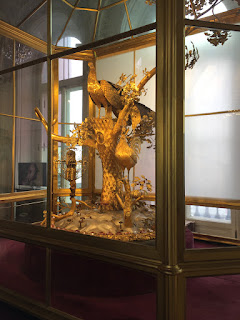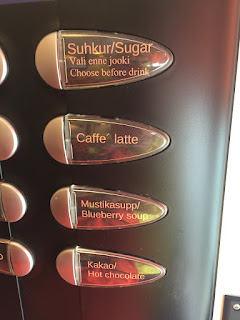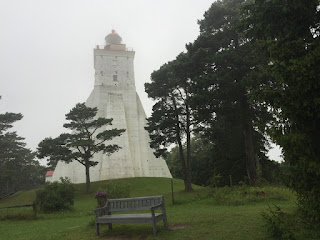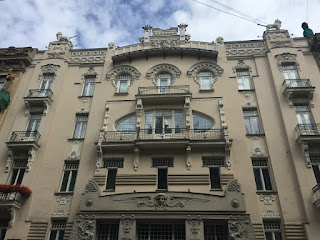Our hotel for this last stop on the trip was located just off Nevsky Prospekt, the main street lined with shops, stores, restaurants and historical sites. Just walking up and down this street and people watching gives a pretty good slice of St. Petersburg life. It is two miles long and goes from the bullseye of the city, the Admiralty building with its golden spire, to Uprising Square. We walked this street for a couple of hours on the day we arrived and marveled at the churches, stores, museums and, of course, people - lots and lots of people. During our stay, we learned that Peter the Great who established St. Petersburg was enamored of the Dutch and designed the city with canals that cut across the two rivers of the city - the Neva and the Fontanka. They are pretty and also serve as a way to control flooding.
Before arriving we talked with a number of people who had been to St. Petersburg and read the recommendations in Rick Steves' guidebook and we decided to do something we have never done. We arranged for a private guide for two days of our stay. We had a car and driver, a guide who was very knowledgeable and accompanied us all day and entrance to all sites without having to stand in line. The first day Timofey Kruglikov took us about 45 minutes outside the center of the city to the small town of Pushkin to see Catherine's Palace and Peterof in Tsarskoye Selo which means Czars' Village. On the way, Timofey gave us a Russian 101 course with emphasis on the Romanovs starting with Peter I (the Great) and ending with Nicholas II (the one we mostly know about because his whole family was assassinated in the Revolution in 1918). The centerpiece of Tsarkoye Selo is the large, salmon and white Catherine's Palace - the Catherine who was married to Peter the Great and became Empress. Over the years it was added on to by Elizabeth (her daughter) and Catherine II (the Great). It was badly damaged in WWII but because it was turned into a museum after the Bolshevik Revolution, there was documentation that allowed restoration.
Delft heater surrounded by art
Gardens and fountains
More of the fountains and pavilions
After Catherine's Palace we shared a lunch at a local restaurant with our guide and then drove to Peterof. This time it was all about the grounds. It sits along the Gulf of Finland because Peter was all about sailing and his Navy. In one of the pavilions we came in and sat alone listening to a quartet sing. It was an unexpected private concert.
The next day our guide Elena and the driver Sergei picked us up at the hotel for a day-long tour of the heart of St. Petersburg including the Kazan Cathedral (shaped like St. Peter's in Rome only bigger) and popular for a "miracle icon" of Our Lady of Kazan. Unlike some of the other churches we visited, this one is still an actual Russan Orthodox church and filled with worshipers. During the Soviet era it was used as a Museum to Atheism. Then we rode over to the Church on Spilled Blood. This is truly an amazing structure which is not a church but a memorial built on the spot where Alexander II was assassinated,
The next stop was St. Isaac's Cathedral, another huge, grand structure with a gold dome that looks like the Capital Building in Washington DC. It is massive inside and considered the leading Russian Orthodox church in the world.
Finally we crossed one of the rivers to see the Peter and Paul Fortress with the chapel that is the burial site of the Romanovs. It is on an island in the Neva River. Its centerpiece is the Sts. Peter and Paul Cathedral with the white marble monuments over the graves of the czars and czarinas from Peter the Great to a special chapel with the remains of Nicholas II, his wife Alexandra and their 4 daughters and one son.
After a brief lunch in the cafe of the Hermitage (the new wing), we began our overview tour of one of the largest museums in the world. The art highlights the collection of European art collected by Catherine the Great. This is really a two for one tour. The first is the art including masterworks by Leonardo, Rembrandt, Matisse, Titian, Michelangelo, Renoir, Picasso, and on and on. The second reason to visit is to walk through and admire the historical rooms themselves as the museum is housed in a palace built by Peter the Great's daughter Elizabeth. The older art is housed in the palace. The newer art is housed across the plaza in a newly renovated General Staff building. The original palace is jammed full of people and tours, many from Asia. The newer building with the newer art is far less crowded and, therefore, more pleasant. Our guide threaded us through the throngs and gave us an Art History I overview of the collection in the palace and then we did the newer building on our own as she left us at the end of the day.
Leonardo's Benois Madonna
Peacock Clock
Raphael's Loggia
Matisse's The Dance
The last day in St. Petersburg we were on our own and finally, the weather was beautiful! We had seen enough of the city with the guides that we had a familiarity with the layout and an idea of what we wanted to see. First, was the Faberge Museum in the beautifully restored Shuvalov Palace where we donned foot coverings to protect the floors and saw much more than a collection of iconic Faberge eggs. It wasn't very crowded and was of manageable size in a lovely setting. The main attraction was the room featuring 14 Faberge eggs. They are a marvel of jewels, gold, and teeny, tiny mechanisms that reveal feature inside feature.
At the top you see the miniature coronation carriage that was held by the beautiful egg to the right.
Other rooms displayed icons, goblets, snuff boxes, watches, porcelain and enamel.
Icons
After a good lunch in a restaurant that specializes in dumplings called Pelmeniya, we decided to tour the Russian Museum in the Mikhailovsky Palace. Unlike the Hermitage, this museum is only for Russian art and felt like more of a window into how Russians saw their country. It was in chronological order and ended with 20th Century art up through the 1980's. The art in the last rooms no longer had to laud Russia. These last paintings are critical of the later Soviet years. We liked this museum better than the Hermitage.
Queue by Alexei Sundukov
We exited the museum through the back and walked through the Summer Gardens all the way to the Neva River. These gardens, filled with people strolling, sitting and listening to bands, is the oldest garden in the city laid out by Peter the Great himself. He commissioned Dutch and French garden engineers and Venetian artists to bring European culture to St. Petersburg. It was open to the public if you were "decently dressed." We finished our day with a river tour where we ordered food and viewed the riverfront of St. Petersburg out to where the cruise ships dock and back.
It wasn't possible to see everything St. Peterburg has to offer in just 4 days but we got a taste.



















































